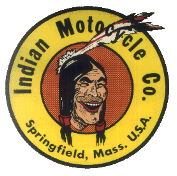First of all, stock up with several cork rings. They frettle, or sliver or shrink or break..or ground too thin and if not, they wear out. Accept only a good dense quality cork. Stock up with (good hardened) thrust washers of the various od. and id. in the engine, thick if you have a surface grinder or buy different thickness.
I set rods .020 total clearance in the flywheels and (- that) between each other. I recon they are 95% splash lubricated so I don't want any tighter. It would be tighter fit if it was positive oil fed through the crankpin as with later Indian oil pumps. Check also that the rod bushing has ample side clearences in the piston. A caveat in general...clearances is better to have on the plus side than on the tight side.
Flywheels internal crankcase total clearance .020" (0,5mm) Then set clearance in the left side crancase to .010(+) (0,25mm+) with the outer washer between the case and drive gear.
When the internal clearance is at spec at .020", (and rods centered in the spigot, obs the dividing line is not in center) mount the drive gear and torque to 70-80 ft.lbs. (8-9Nm) Measure distance between case and gear. Subtract .010"(+) and that is the thickness the thrust washer should have. Grind the washer thickness. Turn the washer ground surface against the gear. Grind, reinstall, check and repeat..
When that .010"(+) measure is at spec, install thrust washer and cork, torque the gear and check with poking with a screwdriver that the washer can be brought to turn with some but not too much resistance.
If not, remove the gear and with the cork in place in the gear, on sandpaper stuck on a flat surface, very very gentle sand down the cork just a little at a time and as equal flat all around as possible.
Because of sand grit stuck in the cork, take out and turn over the cork in the groove if possible without ruining it, mount and check resistance again. Grind, reinstall, check and repeat.. If the cork become too thin you have to replace it or cut a ring of gasket material to shim behind the cork.
Clean up and pre-oil the crankcase bearing before final assembly. Secure the gear center nut with a keyed bend-over washer. Or strong locktite. Or both..
A gear tool is very handy to have. A few broken drill rods welded in a ring..And a gear puller, please don't tap on the gear or shaft with a hammer..
The clutch transmission idler- or primary idler gear should also have .020 total sideplay.


